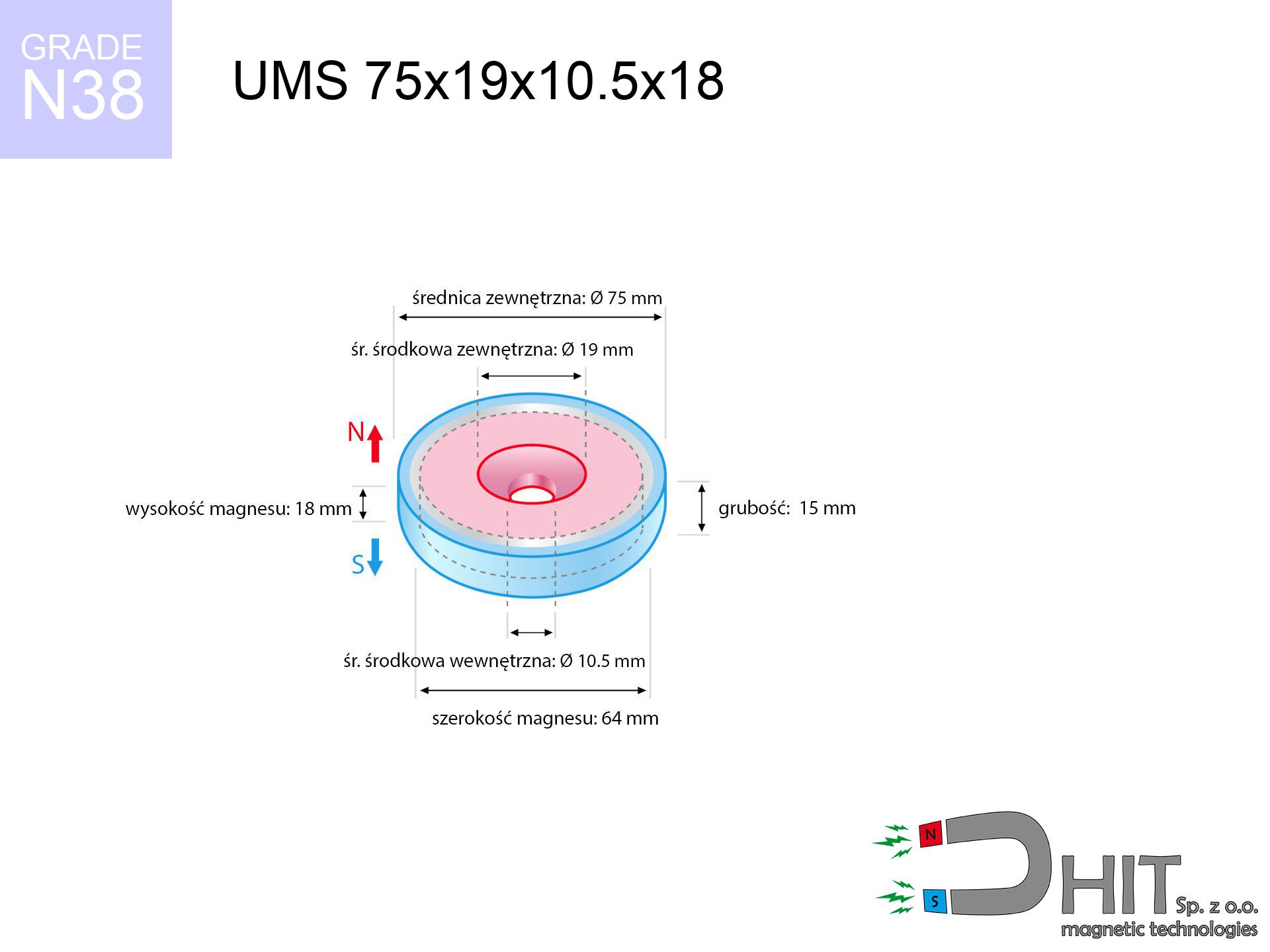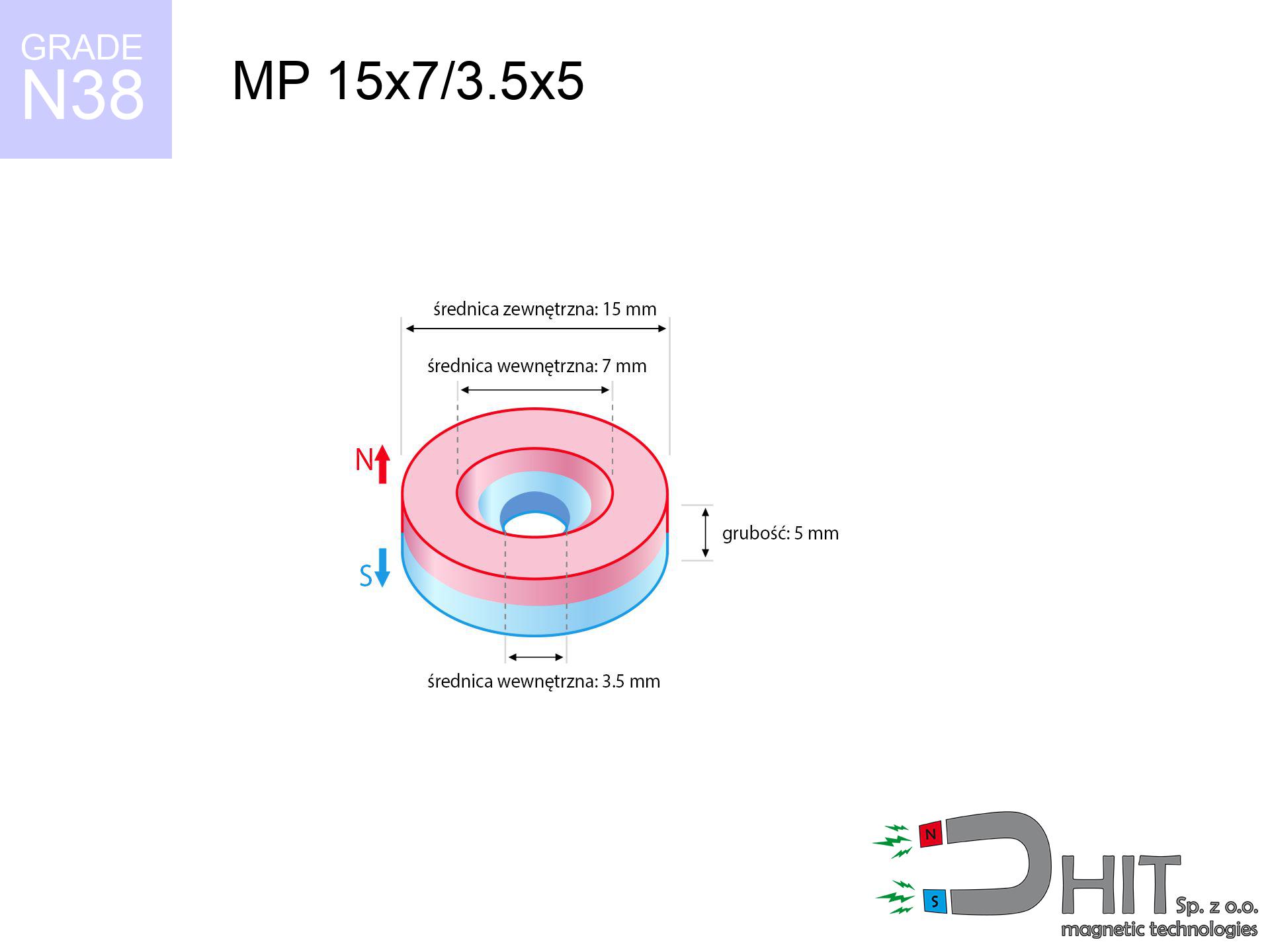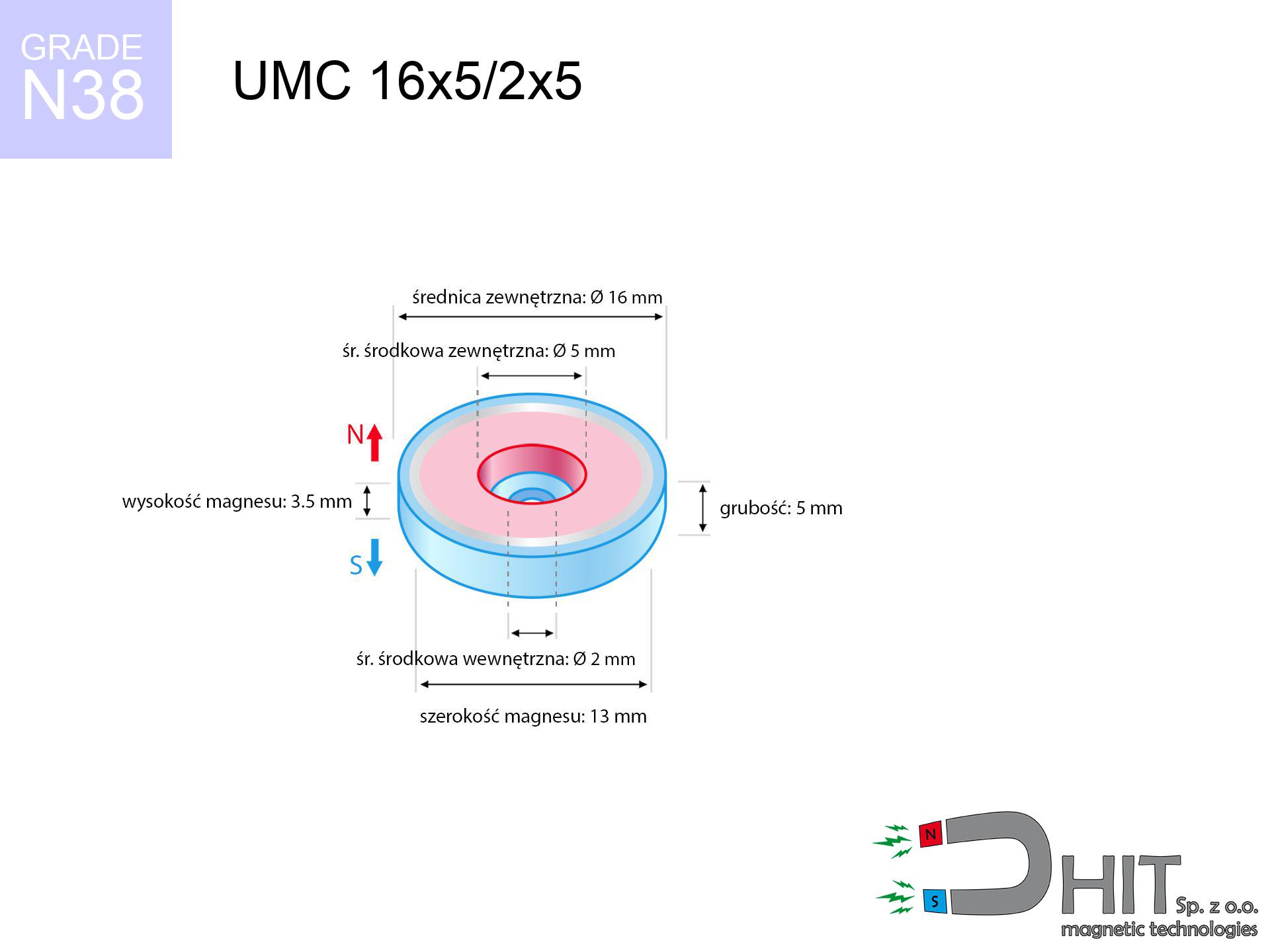UMP 97x40 [M8+M10] GW F300 kg / N38 - search holder
search holder
Catalog no 210337
GTIN/EAN: 5906301813965
Diameter Ø
97 mm [±1 mm]
Height
40 mm [±1 mm]
Weight
2200 g
Load capacity
380.00 kg / 3726.53 N
Coating
[NiCuNi] Nickel
Magnetic Flux
~ 10 000 Gauss [±5%]
300.00 ZŁ with VAT / pcs + price for transport
243.90 ZŁ net + 23% VAT / pcs
bulk discounts:
Need more?
Pick up the phone and ask
+48 888 99 98 98
or get in touch by means of
form
our website.
Specifications as well as structure of neodymium magnets can be reviewed with our
modular calculator.
Same-day processing for orders placed before 14:00.
💡 Check why professionals choose Dhit over cheap substitutes
Don't be fooled by amateur online tests – go for certified quality and specific parameters that guarantee success:
- 📏 Magnet thickness in the casing (min. 10mm) – This is what matters most! Thin magnets are weak. Thanks to the 1cm thickness of N52 neodymium, your magnet "sees" metal even through thick rust and mud.
- 🛡️ Armored protection (Black Epoxy) – Forget about rust. This coating doesn't chip when hitting rocks and protects the magnet in water much better than regular nickel, which fails quickly.
- 🧲 Eyelets that don't steal power – Made of special non-magnetic steel, so they don't stick to the magnet and don't block the force. Important: mount only one eyelet at a time! Using 3 at once is a mistake that weakens the magnet.
- 🧶 Certified rope (min. 8mm) – You gain the certainty that your gear won't stay at the bottom. It's thick and comfortable, so it doesn't cut your fingers when pulling out heavy scrap metal.
- 🚀 Our advantage: We are the only ones combining the strongest N52 neodymium (10mm thick) with non-magnetic eyelets. This is real power and durability you won't find anywhere else.
Invest in solid equipment and enjoy the results!
Technical data - UMP 97x40 [M8+M10] GW F300 kg / N38 - search holder
Specification / characteristics - UMP 97x40 [M8+M10] GW F300 kg / N38 - search holder
| properties | values |
|---|---|
| Cat. no. | 210337 |
| GTIN/EAN | 5906301813965 |
| Production/Distribution | Dhit sp. z o.o. |
| Country of origin | Poland / China / Germany |
| Customs code | 85059029 |
| Diameter Ø | 97 mm [±1 mm] |
| Height | 40 mm [±1 mm] |
| Weight | 2200 g |
| Load capacity ~ ? | 380.00 kg / 3726.53 N |
| Coating | [NiCuNi] Nickel |
| Holder Type | 2 sided |
| Material Type | Structural steel S235 (ferrous) |
| Magnetic Flux | ~ 10 000 Gauss [±5%] |
| Size/Mount Quantity | 2xM8/1xM10 |
| Manufacturing Tolerance | ±1 mm |
Magnetic properties of material N38
| properties | values | units |
|---|---|---|
| remenance Br [min. - max.] ? | 12.2-12.6 | kGs |
| remenance Br [min. - max.] ? | 1220-1260 | mT |
| coercivity bHc ? | 10.8-11.5 | kOe |
| coercivity bHc ? | 860-915 | kA/m |
| actual internal force iHc | ≥ 12 | kOe |
| actual internal force iHc | ≥ 955 | kA/m |
| energy density [min. - max.] ? | 36-38 | BH max MGOe |
| energy density [min. - max.] ? | 287-303 | BH max KJ/m |
| max. temperature ? | ≤ 80 | °C |
Physical properties of sintered neodymium magnets Nd2Fe14B at 20°C
| properties | values | units |
|---|---|---|
| Vickers hardness | ≥550 | Hv |
| Density | ≥7.4 | g/cm3 |
| Curie Temperature TC | 312 - 380 | °C |
| Curie Temperature TF | 593 - 716 | °F |
| Specific resistance | 150 | μΩ⋅cm |
| Bending strength | 250 | MPa |
| Compressive strength | 1000~1100 | MPa |
| Thermal expansion parallel (∥) to orientation (M) | (3-4) x 10-6 | °C-1 |
| Thermal expansion perpendicular (⊥) to orientation (M) | -(1-3) x 10-6 | °C-1 |
| Young's modulus | 1.7 x 104 | kg/mm² |
Chemical composition
| iron (Fe) | 64% – 68% |
| neodymium (Nd) | 29% – 32% |
| boron (B) | 1.1% – 1.2% |
| dysprosium (Dy) | 0.5% – 2.0% |
| coating (Ni-Cu-Ni) | < 0.05% |
Sustainability
| recyclability (EoL) | 100% |
| recycled raw materials | ~10% (pre-cons) |
| carbon footprint | low / zredukowany |
| waste code (EWC) | 16 02 16 |
Other products
Advantages as well as disadvantages of neodymium magnets.
Benefits
- They retain magnetic properties for around ten years – the drop is just ~1% (according to analyses),
- They maintain their magnetic properties even under close interference source,
- By covering with a reflective coating of nickel, the element gains an proper look,
- The surface of neodymium magnets generates a unique magnetic field – this is one of their assets,
- Made from properly selected components, these magnets show impressive resistance to high heat, enabling them to function (depending on their form) at temperatures up to 230°C and above...
- Possibility of exact modeling as well as modifying to atypical requirements,
- Versatile presence in electronics industry – they are used in data components, brushless drives, advanced medical instruments, also complex engineering applications.
- Relatively small size with high pulling force – neodymium magnets offer strong magnetic field in tiny dimensions, which makes them useful in compact constructions
Disadvantages
- They are prone to damage upon too strong impacts. To avoid cracks, it is worth securing magnets in a protective case. Such protection not only protects the magnet but also increases its resistance to damage
- We warn that neodymium magnets can lose their power at high temperatures. To prevent this, we advise our specialized [AH] magnets, which work effectively even at 230°C.
- Due to the susceptibility of magnets to corrosion in a humid environment, we suggest using waterproof magnets made of rubber, plastic or other material stable to moisture, in case of application outdoors
- We recommend casing - magnetic holder, due to difficulties in creating nuts inside the magnet and complicated forms.
- Potential hazard related to microscopic parts of magnets can be dangerous, when accidentally swallowed, which is particularly important in the context of child safety. It is also worth noting that tiny parts of these magnets are able to be problematic in diagnostics medical when they are in the body.
- Higher cost of purchase is a significant factor to consider compared to ceramic magnets, especially in budget applications
Lifting parameters
Best holding force of the magnet in ideal parameters – what it depends on?
- on a base made of mild steel, optimally conducting the magnetic flux
- with a thickness no less than 10 mm
- with a surface cleaned and smooth
- without any clearance between the magnet and steel
- under vertical force direction (90-degree angle)
- in temp. approx. 20°C
Lifting capacity in practice – influencing factors
- Distance – the presence of any layer (rust, dirt, air) interrupts the magnetic circuit, which reduces power steeply (even by 50% at 0.5 mm).
- Angle of force application – highest force is reached only during perpendicular pulling. The resistance to sliding of the magnet along the surface is standardly many times lower (approx. 1/5 of the lifting capacity).
- Substrate thickness – for full efficiency, the steel must be adequately massive. Thin sheet restricts the lifting capacity (the magnet "punches through" it).
- Material type – ideal substrate is high-permeability steel. Hardened steels may have worse magnetic properties.
- Surface structure – the more even the plate, the larger the contact zone and stronger the hold. Unevenness acts like micro-gaps.
- Temperature – temperature increase causes a temporary drop of induction. Check the maximum operating temperature for a given model.
Lifting capacity testing was performed on plates with a smooth surface of suitable thickness, under perpendicular forces, however under shearing force the load capacity is reduced by as much as 5 times. Moreover, even a slight gap between the magnet’s surface and the plate reduces the load capacity.
Safe handling of NdFeB magnets
Handling guide
Before use, read the rules. Sudden snapping can destroy the magnet or injure your hand. Be predictive.
Cards and drives
Do not bring magnets close to a wallet, laptop, or TV. The magnetic field can destroy these devices and erase data from cards.
Pacemakers
Life threat: Strong magnets can turn off heart devices and defibrillators. Do not approach if you have medical devices.
Eye protection
Despite the nickel coating, neodymium is delicate and cannot withstand shocks. Avoid impacts, as the magnet may shatter into hazardous fragments.
Adults only
Product intended for adults. Tiny parts can be swallowed, causing intestinal necrosis. Store away from kids and pets.
Crushing risk
Protect your hands. Two large magnets will snap together instantly with a force of several hundred kilograms, crushing anything in their path. Exercise extreme caution!
Maximum temperature
Standard neodymium magnets (grade N) lose magnetization when the temperature surpasses 80°C. Damage is permanent.
Precision electronics
Be aware: neodymium magnets generate a field that confuses sensitive sensors. Maintain a separation from your mobile, device, and navigation systems.
Fire risk
Combustion risk: Rare earth powder is highly flammable. Do not process magnets in home conditions as this may cause fire.
Skin irritation risks
Medical facts indicate that the nickel plating (the usual finish) is a strong allergen. If you have an allergy, refrain from direct skin contact or choose coated magnets.

![Search magnet UMP 97x40 [M8+M10] GW F300 kg / N38 - GOLD Series Search magnet UMP 97x40 [M8+M10] GW F300 kg / N38 - GOLD Series](https://cdn3.dhit.pl/graphics/banners/magnet.webp)
![UMP 97x40 [M8+M10] GW F300 kg / N38 - search holder](https://cdn3.dhit.pl/graphics/products/ump97x40-m8+m10-gw-f-300-kg-kic.jpg)





